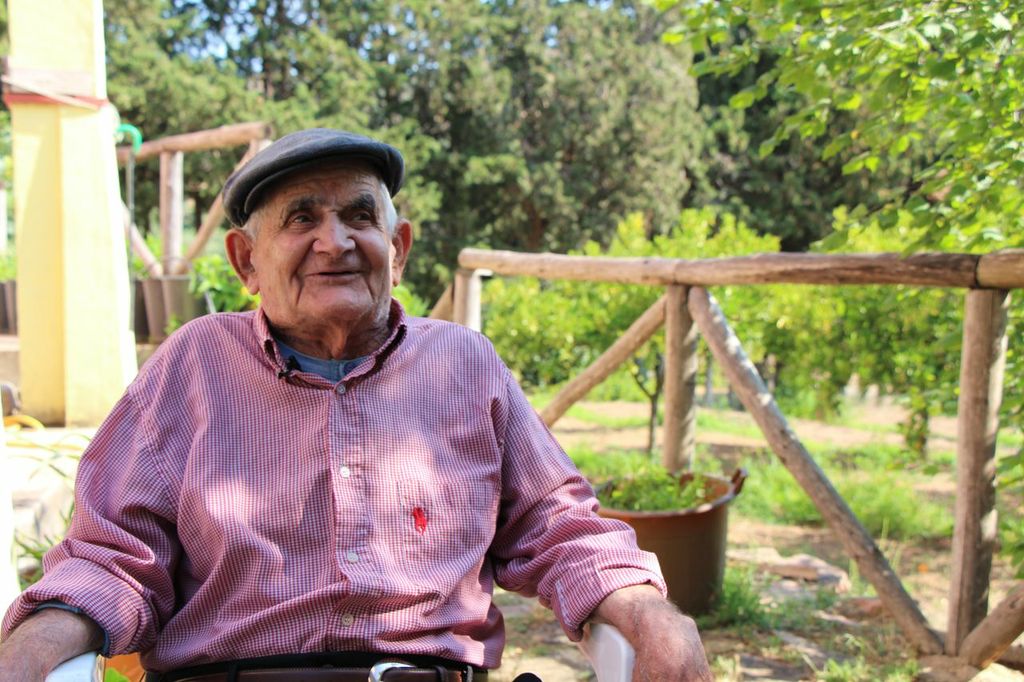What’s the secret to living a long life? It depends on whom you ask – and perhaps where you live.
While researching the lifestyles of some of the world’s oldest people, Asa Eslocker and Harriett Jameson, both master’s degree candidates in landscape architecture in the University of Virginia’s School of Architecture, would often receive invitations to join the near-centenarians and their families for dinner.
“The people in California had these perfect vegan diets,” Jameson said. But that lifestyle choice was absent from the long-living communities in eastern Sardinia, Italy, where she and Eslocker were served suckling pig at nearly every home they visited. The Sardinian families “would laugh at us and say, ‘It will make you live longer!’”
Jameson and Eslocker, recipients of the 2013 Benjamin Howland Fellowship, are researching “Blue Zones,” communities with some of the world’s highest longevity rates. The duo is spending the summer traveling to Loma Linda, Calif., Sardinia, and Okinawa, Japan, to study the role physical environment plays in communities whose citizens live and work well past the age of 80.
At first glance, the cultures of Blue Zone communities are distinctly different: a vegan, Seventh-Day Adventist community in Loma Linda; a close-knit, jovial agricultural community in Sardinia; and a quiet-natured, tradition-laden community in Okinawa.
As Eslocker often puts it, longevity is a puzzle. “This idea of longevity is something everyone can relate to,” he said. “We’re looking at what it is about these places that can be a small piece of that puzzle. We’re looking to analyze the public spaces, the landscapes and the way people use their neighborhoods and communities to find commonalities.”
Though many studies have been conducted on the correlation between diet and exercise or genetics and lifespan, little research exists on the role physical environment plays on longevity.
“We know that there is a very strong connection between physical wellbeing and psychological wellbeing and vice-versa,” Eslocker said. “In Loma Linda, there’s a whole culture of people being outside, gardening, walking their pets, going to the main central gym where they socialize with their friends and exercise.”
“In Sardinia, a lot of the towns are very dense, so people see their friends on the way to church everyday,” Jameson added. “Oftentimes they live with their family.”
“People also have a connection with their view,” she said. “If you have a beautiful view, it reduces your stress level and psychologically makes you feel good. Physically, it’s increasing your serotonin and all these things, and that reduction in stress can also reduce your risk of a heart attack. … But it’s one of those things that’s hard to quantify in what we’re doing.”
During their travels, Jameson and Eslocker have had the opportunity to observe and interview many Blue Zone residents, including a family in Sardinia that includes the Guinness Book of World Records’ oldest siblings – nine siblings whose collective age adds up to 828 years.
Although based in landscape architecture, the project has garnered interest from a wide range of people and organizations interested in the landscape and longevity link. The team received support from U.Va.’s Center for Design and Health, Contemplative Sciences Center and Center for International Studies, and from the local Jefferson Area Board for Aging to carry out the project.
Reuben Rainey, professor of landscape architecture and co-director of the Center for Design and Health, has mentored the team since near the beginning of the project’s inception last year.
“Often in the literature about healthy communities, sense of place is neglected,” Rainey said. “It’s interesting to us and important to us that this project is researching the qualities of a spatial environment, which involves everything from the health of the ecosystem to the community life, especially public places, to its culture.”
The team also received support from individuals in many areas of the U.Va. community, including professors and experts in religious studies, urban and environmental planning and public health sciences.
“We’ve been incredibly lucky reaching across Grounds and finding different organizations that have helped us either as advisers or financially with the project,” Jameson said. “We’ve found people who have helped us find more scientific research and back up the ideas that we have.”
Eslocker’s former work as an ABC News journalist inspired the team to capture its research in a short documentary film, “Landscapes of Longevity,” which includes hand drawings, diagrams such as cross-sections, mapping, photography and most prominently, personal interviews with many of the elderly people they meet. The project will serve as part of Jameson and Eslocker’s master’s thesis.
They are also maintaining a Landscapes of Longevity blog with photos, video, stories and other information they’ve learned from their travels this summer.
The team will present their documentary in April, where they hope to also hold a symposium at the Architecture School featuring panelists from schools across the University and possibly people they’ve met during their travels.
This is part of their mission as well, they said: sharing how landscape architecture and urban planning can impact so many different fields of study – and areas of life.
As they seek out the links between space, sense of place and a long life, they gain fond memories of the centenarians they’ve met along the way.
“One of the ladies we ended up talking to [in Sardinia] was a 102-year-old woman who still makes pastries everyday,” Jameson said.
“And she had this rolling pin, ” Eslocker added.
“She was waving this rolling pin in the air, flour was flying everywhere … and she comes up to Asa and grabs his arm and says, ‘You know, I’m single and looking for a husband,’” Jameson laughed. “‘And you might not know it now, but you’re going to get older too!’”
— by Lauren Jones
Media Contact
Article Information
August 7, 2013
/content/landscapes-longevity-uva-architecture-students-study-links-between-location-and-lifespan

